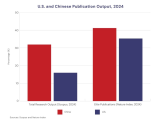You are using an out of date browser. It may not display this or other websites correctly.
You should upgrade or use an alternative browser.
You should upgrade or use an alternative browser.
News on China's scientific and technological development.
- Thread starter Quickie
- Start date
supercat
Colonel
Useful for distributed AI training and cloud computing, among other things
China to build millisecond-latency computing network across urban areas by 2027
Robosense launches AC2 robot eye which is an integrated Lidar dToF + RGBD camera & IMU.
Modular integrated optical sensors for use in multiple form factors is pretty impressive, it just makes sense.
Robosense launches AC2 robot eye which is an integrated Lidar dToF + RGBD camera & IMU.
Interesting chart from the news. Chinese domestic market share for LIDAR. Around 2 million installed capacity, with presumably around 20 million vehicle sales, so only ~10% penetration. LIDAR has room to grow much further.
supplier | Installed capacity | market share |
Huawei Technologies | 643826 | 41.1% |
Hesai Technology | 514189 | 32.8% |
RoboSense | 305171 | 19.5% |
Tudatong | 104700 | 6.7% |
other | 184 | 0.01% |
big day in China's material science industry as 长盛科技/CSST has achieved stable production in its 1000s ton ZA70 (T1100 class) production line. Its ZA70 product first passed design review back in Sep 2024.
In past year, CSST has collaborated with AVIC, Shenzhen University and several others to form COMAC's "Domestic T1100-grade carbon fiber screening and evaluation". It has conducted process optimization and stabilized production across 19 batches in 3 phases on a fully domestically produced line. Batch yield have surpassed 95%. Its tensile strength of settled on 6600MPa, 6600MPa and 6600MPa (note modulus is difference also)
It has worked to improve ZA70's compatibility with aerospace resin to improve composite material performance. Improve composite tensile strength from 3300 6600MPa to 3705 6600MPa.
ZA60XC and ZA65XC are CSST T1000 product and ZA55GC is T800G. It's ZA55GC has passed COMAC's PCD management system certification and entered service on C919.
CSST will be focusing on 4th gen carbon fibers (T1200 grade) and a new gen of ultra tough CFRP as future development
supercat
Colonel
The world's first magnetic resonance platform can record and analyze the MRI and full-brain scalp electroencephalogram (EEG) in real time simultaneously.
The world's first magnetic resonance platform customized for brain-computer interface (BCI) technology was recently launched in north China's Tianjin Municipality. The platform has established a neuroimaging magnetic resonance system, providing key support for the research and development of next-generation BCI technology.
The new platform can simultaneously perform nuclear magnetic imaging and EEG recording, accurately capture subtle changes in brain activity, locate the position of these activities with sub-millimeter accuracy, and capture the timing of brain activities with sub-second speed.
Last edited:
Chinese scientific publications have pulled ahead in both quantity and quality.

The Nature Index, which tracks publications in 145 of the world’s most elite natural science journals — including Nature, Science, Cell, and Physical Review Letters — shows China’s lead in 2024 with 37,273 articles compared to America’s 31,930. This represents a stunning 17 percent advantage for China in what has long been considered the gold standard of scientific excellence and follows earlier work in the Web of Science and other databases showing .
This isn’t just another data point. The Nature Index represents the final frontier — the last major metric where the United States maintained clear scientific superiority. Unlike broader publication counts that lower-tier journals can inflate, these 145 journals employ rigorous international peer review and have rejection rates often exceeding 90 percent. Getting published in Nature or Science demonstrates a genuine scientific breakthrough, not just productivity.
China’s takeover happened with remarkable speed. As recently as 2020, the United States led China by 53 percent in Nature Index publications (29,172 to 19,097). But China’s growth rate of 18 percent per year vastly outpaced America’s 2.3 percent annual growth. By 2023, the gap narrowed to just 7 percent. In 2024, China pulled decisively ahead — partly due to returnees who are now publishing in China.

